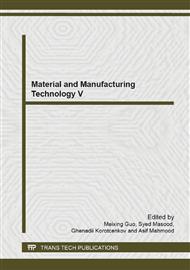[1]
M. Andréa, G. Tavares, A.S. Marcos, J.A. Andrade, R. Cestari and F.S. Vieira: An Oilwell Cement Slurry Additivated with Bisphenol Iglycidilether/Sophoronediamine -Kinetic Analysis and Multivariate Modelings at Slurry/Hcl Interfaces, Journal of Hazardous Materials Vol 170 (2009).
DOI: 10.1016/j.jhazmat.2009.04.085
Google Scholar
[2]
K.R. Backe, O.B. Lile, S.K. Lyomove, H. Elvebakk, and P. Skalle: Characterising Curing Cement Slurries by Permeability, Tensile Strength, and Shrinkage, Society of Petroleum Engineers (SPE 38267), (1997).
DOI: 10.2118/38267-ms
Google Scholar
[3]
A.C. Johnson and I. D. N. Yunus: Particleboards from Rice Husk: A Brief Introduction to Renewable Materials of Construction, JURUTERA (2009) pp.12-15.
Google Scholar
[4]
T. Huang and J.B. Crews: Nanotechnology Applications in Viscoelastic Surfactant Stimulation Fluids. Paper presented at the European Formation Damage Conference, Scheveningen, and The Netherlands, (2007).
Google Scholar
[5]
R.C. Patil and A. Deshpande: Use of Nanomaterials in Cementing Applications. SPE International Oilfield Nanotechnology Conference, Noordwijk, The Netherlands (2012).
Google Scholar
[6]
P.C. Aitcin, P.A. Hershey and Pinsonneault: Effect Of The Addition Of Condensed Silica Fume On The Compressive Strength Of Mortars And Concrete, American Ceramic Society Vol. 22 (2981), pp.286-290.
Google Scholar
[7]
W. Roddy and O.K.D. Craig: Well Treatment Compositions and Methods Utilizing Nano-Particles. U.S. Patent 02777116 A1 U (2008).
Google Scholar
[8]
M.O. Onyekonwu and N.A. Ogolo: Investigating the Use of Nanoparticles in Enhancing Oil Recovery. Paper presented at the Nigeria Annual International Conference and Exhibition, Tinapa - Calabar, Nigeria (2010).
DOI: 10.2118/140744-ms
Google Scholar
[9]
T.P.S. Shih Chang and T. Hsiao: Effect of Nanosilica on Characterization of portland composite, Material Science and Engineering A Vol. 424 (2006), pp.266-274.
DOI: 10.1016/j.msea.2006.03.010
Google Scholar
[10]
H. Li, H.G. Xiao, J. Yuan and J. Ou: Microstructure of cement mortar with nano-particles. Composites Part B Engineering Vol 35(2) (2004), pp.185-189.
DOI: 10.1016/s1359-8368(03)00052-0
Google Scholar
[11]
M. Amanullah and A.M. Al-Tahini: Nano-Technology – Its Significance in Smart Fluid Development for Oil and Gas Field Application. Paper presented at the SPE Saudi Arabia Section Technical Symposium, Al-Khobar, Saudi Arabia (2004).
DOI: 10.2118/126102-ms
Google Scholar
[12]
B. Ju, T. Fan and M. Ma: Enhanced Oil Recovery by Flooding with Hydrophilic Nanoparticles, China Particuology Vol. 4(1) (2006), pp.41-46.
DOI: 10.1016/s1672-2515(07)60232-2
Google Scholar
[13]
F. Daou and B. Piot: Cement Slurry Performance and Set Cement Properties vs. Microsilica Densification, Society of Petroleum Engineers (SPE112701), (2008).
DOI: 10.2118/112701-ms
Google Scholar
[14]
American Petroleum Institute: Specification for Materials and Testing for Well Cements , API Spec. 10 A 25th edition. American Petroleum Institute, Washington DC, (2002).
Google Scholar
[15]
American Petroleum Institute. Recomended practice for Testing Well Cements, API Spec. 10 B 1st edition, American Petroleum Institute, Washington DC (2010).
Google Scholar
[16]
T. Nittaya and N. Apinon: Preparation Of Nanosilica Powder Form Rice Husk Ash By Precipitation Method, Journal of Science Vol. 35 (1) (2008), pp.206-211.
Google Scholar
[17]
K.R. Backe, O.B. Lile and S.K. Lyomove, Laboratory Study on Oilwell Cement and Electrical Conductivity, Society of Petroleum Engineers (SPE56539), (1997).
Google Scholar
[18]
A. Campillo, J.S. Guerrero, A. Dolado, J.A. Porro and S. Goñi: Improvement of Initial Mechanical Strength by Nanoalumina in Belite Cements, Materials Letters Vol. 61 (2007), pp.1889-1892.
DOI: 10.1016/j.matlet.2006.07.150
Google Scholar
[19]
T.E. Ershadi, A. R Rabani and H. Soltanian: Nanotechnology Applications in Viscoelastic Surfactant Stimulation Fluids, International Journal of Environmental Science and Development Vol. 2(2) (2011).
Google Scholar
[20]
J. K. Fink: Petroleum Engineer's Guide to Oil Field Chemical and Fluids (Vol. 1): Elsevier's Science & Technology. Hohston : Schlumberger Educational Services Vol. 3 (1) (2012), pp.3-35.
Google Scholar
[21]
G. Li: Properties of High-Volume Fly Fsh Concrete in Corporating Nano-SiO2, Cement and Concrete Research Vol. 34 (2004), pp.1043-1094.
DOI: 10.1016/j.cemconres.2003.11.013
Google Scholar
[22]
K.E. Lolad: Silica Fume in Concrete, University of Trondheim, Norway (1981).
Google Scholar
[23]
S.J.L. Luciano, A. Labrincha, V.M. Ferreira, H. Dachamir, L.R. Wellington: Effect of Nano-Silica on Rheology and Fresh Properties of Cement Pastes and Mortars, Construction and Building Materials. Vol. 23 (2009), pp.2487-2491.
DOI: 10.1016/j.conbuildmat.2009.02.005
Google Scholar
[24]
E.B. Nelson, M. Michaux and B. Drochon: Cement Additive and Mechanisms of Action. Nelson and Guilot. Well Cementing Chapter 3, Second Edition, Schlumberger Educational Services, Texas (2007), pp.49-90.
Google Scholar
[25]
A.K. Santra, P. Boul and X. Pang: Influence of Nanomaterials in Oilwell Cement Hydration and Mechanical Properties. Paper presented at the SPE International Oilfield Nanotechnology Conference, Noordwijk, The Netherlands (2012).
DOI: 10.2118/156937-ms
Google Scholar
[26]
.P. Skalle, J. Sveen and H. Justnes: Vibration of Oil Well Cement. Paper presented at the Abu Dhabi Petroleum Conference, Abu Dhabi (1992).
DOI: 10.2118/24508-ms
Google Scholar
[27]
J.S. Doladoa, I. Campillo, E. Erkizia, J.A. Ibanez, A. Porro, A. Guerrero and S. Goni: Effect of Nanosilica Addition on Belite Cement Pastes Held in Sulfate Solutions, Journal of the American Ceramic Society, Vol. 90 (2007), pp.3973-3976.
DOI: 10.1111/j.1551-2916.2007.02034.x
Google Scholar
[28]
E.M. Moulin, M.L. Roy, S.E. Caddell, B. Vidick and T.L. Hughes: New Techniques for Solving Cementing Problems in a Field Laboratory. Paper presented at the European Petroleum Conference, Cannes, France (1992).
DOI: 10.2118/24980-ms
Google Scholar
[29]
O.O. Fidelis and U.N. Okonkwo: Effects of Rice Husk Ash on Some Geotechnical Properties of Lateritic Soil, Journal of Practices and Technologies Vol. 15 (2009), 67-74.
Google Scholar
[30]
K. Xiangling and M. Ohadi: Applications of Micro and Nano Technologies in the Oil and Gas Industry - Overview of the Recent Progress. Paper presented at the Abu Dhabi International Petroleum Exhibition and Conference, Abu Dhabi, UAE (2010).
DOI: 10.2118/36188-ms
Google Scholar


